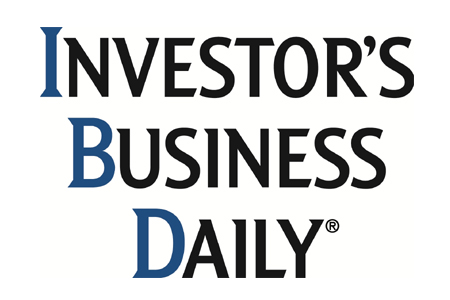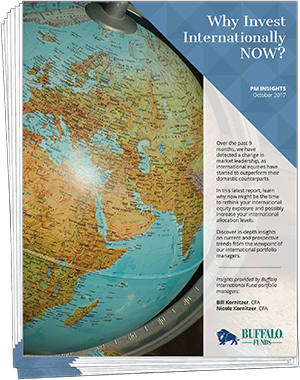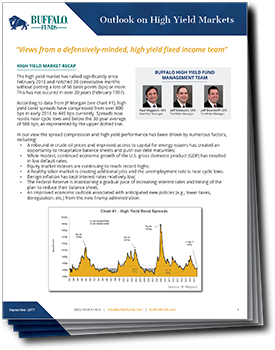No Results Found
The page you requested could not be found. Try refining your search, or use the navigation above to locate the post.
Home > Insights & News > White Papers & Research > PM Insights
The Buffalo International Fund (BUFIX) portfolio managers, Bill Kornitzer, CFA, and Nicole Kornitzer, CFA, recently held a live Q&A session for investment advisers, who posed questions regarding the current state of the international markets:
What’s your take on the current status of the international market in relation to the U.S. cycle?
Bill Kornitzer (4:20)
What is your opinion on President Trump’s recent announcement regarding tariffs?
Bill Kornitzer (8:10)
Nicole Kornitzer (0:58)
INVESTMENT PHILOSOPHY & PROCESS
The BUFIX portfolio managers also gave more insight into their process and investment philosophy:
Can you give us an example of a company in the portfolio that shows your process at work?
Bill Kornitzer (5:36)
Nicole Kornitzer (3:26)
What differentiates your fund from others?
Bill Kornitzer (2:34)
Nicole Kornitzer (1:08)
If you are a financial professional and would like to set up a call with one of our portfolio managers, please send a request to advisers@buffalofunds.com.

“World markets are relatively inexpensive compared to the U.S., by the widest margin in 10 years. Given the credit backdrop and where we are in the economic cycles and where stocks are priced, the opportunity is really skewed more favorably towards the international scene.“
~ Bill Kornitzer, Co-Portfolio Manager, Buffalo International Fund
BUFIX Q4 Fact Sheet
BUFIX Q4 PM Commentary
Latest Whitepaper – “Why Invest Internationally NOW”
BUFIX Fund Managers
The page you requested could not be found. Try refining your search, or use the navigation above to locate the post.
Annualized Performance (%)
| As of 3/31/25 | 3 MO | YTD | 1 YR | 3 YR | 5 YR | 10 YR | Since Inception |
|---|---|---|---|---|---|---|---|
| BUFFALO INTERNATIONAL FUND - Investor | 5.10 | 5.10 | -2.19 | 2.67 | 10.87 | 7.16 | 5.32 |
| BUFFALO INTERNATIONAL FUND - Institutional | 5.20 | 5.20 | -2.01 | 2.83 | 11.05 | 7.32 | 5.48 |
| FTSE All World Ex-US Index | 5.05 | 5.05 | 6.65 | 4.98 | 11.67 | 5.62 | 3.40 |
| Lipper International Fund Index | 6.66 | 6.66 | 6.22 | 6.06 | 12.38 | 5.72 | 3.50 |
Annual expense ratio: 1.05%. The Morningstar category average represents a universe of funds with similar objectives. Average annual total return represents past performance and is no guarantee of future results. Investment return and principal value will fluctuate and redemption value may be more or less than original cost. Fund performance current to the most recent month-end may be lower or higher than the performance quoted and can be obtained here.
Opinions expressed are subject to change, are not intended to be a forecast of future events, a guarantee of future results, nor investment advice.
As of 12/31/17, the Buffalo International Fund held CTS Eventim (1.05%) and Sartorius Stedim Biotech (1.50%). Fund holdings are subject to change and should not be considered a recommendation to buy or sell any security.
ECB stands for European Central Bank. “S&P trailing PE” references the S&P 500 price-to-earnings ratio, based on the trailing twelve months. The S&P 500 is a capitalization weighted index of 500 large capitalization stocks which is designed to measure broad domestic securities markets. The Russell Global is an unmanaged index that measures the performance of the global equity market based on all investable equity securities, excluding companies assigned to the United States. It is not possible to invest directly in an index. EBITDA stands for Earnings Before Interest, Taxes, Depreciation, and Amortization. R&D is research and development. FDA is the Food and Drug Administration. TPP stands for Trans-Pacific Partnership. UK stands for United Kingdom. EU stands for European Union. VAT stands for Value-Added Tax. GDP stands for Gross Domestic Product.
Stay up-to-date with the most recent media coverage and press releases about the Buffalo Funds.

Buffalo Funds Small Cap co-portfolio manager Jamie Cuellar, CFA, was recently interviewed by The Wall Street Transcript, where he discussed how his team analyzes small-cap company valuations and why they view the asset class as very inefficient. He also provides several examples of companies within his portfolio that highlight his team’s investment strategy at work:
Jamie also gave his outlook on small-cap companies in the United States in the coming year, including the impact of the current economy, the recent tax cuts, and the repatriation of corporate cash holdings back to the United States.
“We believe that by investing in an actively managed and diversified portfolio of companies that benefit from long-term industrial, technological or general market trends, and trading at attractive valuations, are going to lead to superior growth of capital over time.“ ~ Jamie Cuellar, CFA, Co-Portfolio Manager, Buffalo Small Cap Fund
To access The Wall Street Transcript article click here.

Performance data quoted represents past performance; past performance does not guarantee future results. The investment return and principal value of an investment will fluctuate so that an investor’s shares, when redeemed may be worth more or less than their original value. Current performance may be lower or higher than the performance quoted. Performance data current to the most recent month-end may be obtained here. Performance data current to the most recent quarter-end may be obtained here.
Diversification does not assure a profit, nor does it protect against a loss in a declining market.
Active investing has higher management fees because of the manager’s increased level of involvement while passive investing has lower management and operating fees. Investing in both actively and passively managed mutual funds involves risk and principal loss is possible. Both actively and passively managed mutual funds generally have daily liquidity. There are no guarantees regarding the performance of actively and passively managed mutual funds. Actively managed mutual funds may have higher portfolio turnover than passively managed funds. Excessive turnover can limit returns and can incur capital gains.
Opinions expressed are those of the author or Funds and are subject to change, are not intended to be a forecast of future events, a guarantee of future results, nor investment advice.
References to other mutual funds should not to be considered an offer to buy or sell these securities.
A complete list of the Fund’s holdings can be found here. Fund holdings are subject to change and should not be considered a recommendation to buy or sell any security.
Earnings growth is not representative of the fund’s future performance.
AUM stands for Assets Under Management. API stands for Application Programming Interface. ARPU stands for Average Revenue Per User. SMB stands for Small/Medium-size Business. EBITDA stands for Earnings Before Interest, Taxes, Depreciation, Amortization. Cash flow is the total amount of money being transferred into and out of a business. REIT stands for Real Estate Investment Trust. Dividend yield is a dividend expressed as a percentage of a current share price. GDP stands for Gross Domestic Product. M&A stands for Mergers & Acquisitions. P&L stands for Profit & Loss. The Russell 2000 is an unmanaged index that consists of the smallest 2,000 securities in the Russell 3000 Index, representing approximately 10% of the Russell 3000 total market capitalization. It is not possible to invest directly in an index.
Jamie Cuellar, co-portfolio manager, discusses how his team analyzes small-cap company valuations and why they view the asset class as very inefficient, while providing several examples of companies within his portfolio that highlight his team’s investment strategy at work.
Joel Crampton
Director of Marketing
(913) 647-9881
Stay up-to-date with the most recent media coverage and press releases about the Buffalo Funds.

The Buffalo Discovery Fund (BUFTX) is an Investor’s Business Daily 2018 Best Mutual Funds Award Winner, in the 3rd annual ranking by the investment publication, announced this week. BUFTX was included in 3 categories:
Funds named to IBD’s list were chosen because they have outperformed the broader market over the past 1, 3, 5, and 10-year periods, as of 12/31/17. In order to make the list, funds must have outperformed in all four time periods. IBD made its selections from 2,806 mutual funds that met the criteria of having at least $100 million in assets and 10 years of operation.
“We’re honored that our Discovery Fund has been recognized in this way by IBD. This fund exemplifies our firm’s goal of consistently delivering strong risk-adjusted performance to our shareholders,“ said Clay Brethour, president of the Buffalo Funds and co-manager of the Buffalo Discovery Fund.
The Buffalo Discovery Fund is managed by Clay Brethour and Dave Carlsen, a team that has been in place since 2004.
Originally launched in 2001 as the Science & Technology Fund, the Discovery Fund has consistently delivered benchmark-beating performance since inception, with a focus on innovation as a key driver in their outperformance. IBD recently profiled the Fund in their March 2018 edition: Innovators Fuel Buffalo Discovery Fund Outperformance
To view IBD’s complete list and analysis of the Best Mutual Funds 2018, please visit: www.investors.com/best-mutual-funds-awards
| As of 12/31/17 | 1 YR | 3 YR | 5 YR | 10 YR |
|---|---|---|---|---|
| Buffalo Discovery Fund | 25.44 | 11.84 | 16.16 | 11.46 |
| Russell Midcap Growth Index | 25.27 | 10.30 | 15.30 | 9.10 |
| S&P 500 Index | 21.83 | 11.41 | 15.79 | 8.50 |
Performance data quoted represents past performance; past performance does not guarantee future results. The investment return and principal value of an investment will fluctuate so that an investor’s shares, when redeemed may be worth more or less than their original value. Current performance may be lower or higher than the performance quoted. Performance data current to the most recent month-end may be obtained here. Performance data current to the most recent quarter-end may be obtained here. Performance is annualized for periods greater than 1 year.
Opinions expressed are those of the author or Funds and are subject to change, are not intended to be a forecast of future events, a guarantee of future results, nor investment advice.
References to other mutual funds should not to be considered an offer to buy or sell these securities.
BUFTX named to Investor’s Business Daily Best Mutual Funds 2018 list in the Midcap, U.S. Diversified, and Growth fund categories.

Joel Crampton
Director of Marketing
(913) 647-9881
The page you requested could not be found. Try refining your search, or use the navigation above to locate the post.
Stay up-to-date with the most recent media coverage and press releases about the Buffalo Funds.

Discover in-depth insights on current and prospective trends from the viewpoint of our international portfolio managers.
Over the past 9 months, we have detected a change in market leadership, as international equities have started to outperform their domestic counterparts. In this latest report, learn why now might be the time to rethink your international equity exposure and possibly increase your international allocation levels.
The portfolio managers of the Buffalo International Fund go in-depth on current and prospective trends that investors and their advisers should be aware of when examining their investment strategy.
In this report, we cover:
Discover how our International Fund portfolio managers, who operate within the international equity asset classes on a daily basis, view today’s international markets. See for yourself why we believe now is the time for investors to rethink international equity exposure and consider increasing international stock allocations.
We get to know the companies we invest in and learn how they run their business.
We identify Top-Down broad, secular growth trends and search for companies from the Bottom-Up.
We construct our portfolios based on our own proprietary investment strategy.
Sticking to our disciplined investment strategy ensures we maintain a consistent, balanced approach.
The Morningstar Rating™ for funds, or "star rating", is calculated for managed products (including mutual funds, variable annuity and variable life subaccounts, exchange-traded funds, closed-end funds, and separate accounts) with at least a three-year history. Exchange-traded funds and open-ended mutual funds are considered a single population for comparative purposes. It is calculated based on a Morningstar Risk-Adjusted Return measure that accounts for variation in a managed product's monthly excess performance, placing more emphasis on downward variations and rewarding consistent performance. The top 10% of products in each product category receive 5 stars, the next 22.5% receive 4 stars, the next 35% receive 3 stars, the next 22.5% receive 2 stars, and the bottom 10% receive 1 star. The Overall Morningstar Rating™ for a managed product is derived from a weighted average of the performance figures associated with its three-, five-, and 10-year (if applicable) Morningstar Rating™ metrics. The weights are: 100% three-year rating for 36-59 months of total returns, 60% five-year rating/40% three-year rating for 60-119 months of total returns, and 50% 10-year rating/30% five-year rating/20% three-year rating for 120 or more months of total returns. While the 10-year overall star rating formula seems to give the most weight to the 10-year period, the most recent three-year period actually has the greatest impact because it is included in all three rating periods.
The Buffalo International Fund received 4 stars among 325 for the 3-year, 4 stars among 280 for the 5-year, and 5 stars among 192 Foreign Large Growth funds for the 10-year period ending 9/30/17.
©2017 Morningstar, Inc. All Rights Reserved. The information contained herein: (1) is proprietary to Morningstar; (2) may not be copied or distributed; and (3) is not warranted to be accurate, complete or timely. Neither Morningstar nor its content providers are responsible for any damages or losses arising from any use of this information. Past performance is no guarantee of future results.
Click here for current ratings of the Buffalo Funds.
The Overall Morningstar Rating™ for a managed product is derived from a weighted average of the performance figures associated with its three-, five-, and 10-year (if applicable) Morningstar Rating™ metrics.
While the U.S. News Mutual Fund Score combines all five equally weighted category scores to achieve its weighting, Lipper intends its measures to be used as individual assessments of a fund's ability to meet specific goals, rather than as a cumulative measure of fund quality. Lipper rankings are comprised of five unique measures (Total Return, Consistent Return, Preservation, Expense, and Tax Efficiency), each with a 1-to-5 score, ranking each fund against its peers. The highest 20% of funds in each peer group are named Lipper Leaders, the next 20% receive a rating of 4, the middle 20% are rated 3, the next 20% are rated 2, and the lowest 20% are rated 1. The overall calculation is based on an equal-weighted average of percentile ranks for each measure over three-, five-, and ten-year periods (if applicable). Lipper Ratings for Total Return reflect funds’ historical total return performance relative to peers. Lipper Ratings for Consistent Return reflect funds’ historical risk-adjusted returns, relative to peers. Lipper Ratings for Preservation reflect funds’ historical loss avoidance relative to other funds within the same asset class. Lipper Ratings for Tax Efficiency reflect funds’ historical success in postponing taxable distributions relative to peers. Lipper Ratings for Expense reflect funds’ expense minimization relative to peers with similar load structures.
The Zacks Mutual Fund Rank ranks funds on a scale from 1 to 5, with 1 being a Strong Buy and 5 being a Strong Sell. Each quarter, Zacks updates their Mutual Fund Rank by evaluating the average Zacks Rank for the stocks owned by the fund and blending this with other criteria their studies show is beneficial in finding funds that will outperform in the future. In general, the higher the average Zacks Rank for the stocks in the fund, then the higher the Zacks Mutual Fund Rank.
TheStreet.com Ratings Investment Ratings for Funds condense the available fund performance and risk data into a single composite opinion of each fund's risk-adjusted performance. “A (Buy) Excellent” rating means the fund has an excellent track record of maximizing performance while minimizing risk, thus delivering the best possible combination of total return on investment and reduced volatility. “B (Buy) Good” rating means the fund has a good track record of balancing performance with risk. “C (Hold) Fair” rating ratings means the fund has a track record which is about average. “D (Sell) Weak” rating means the fund has underperformed the universe of other funds given the level of risk in its underlying investments, resulting in a weak risk-adjusted performance. “E (Sell) Very Weak” rating means the fund has significantly underperformed most other funds given the level of risk in its underlying investments, resulting in a very weak risk-adjusted performance. The plus sign (+) is an indication that the fund is in the top third of its letter grade. The minus sign (-) is an indication that the fund is in the bottom third of its letter grade. “U Unrated” rating means the fund does not have sufficient history to make a reliable assessment of its risk-adjusted performance.
The CFRA Rankings range from five-star (highest) to one-star (lowest) and follow a normalized distribution curve, based upon the fund’s rank in its Category. Top 10% receive five stars, next 20% receive four stars, middle 40% receive three stars, next 20% receive two stars, and the bottom 10% receive one star. Rankings are refreshed on a weekly basis to incorporate the latest inputs from the holdings-based analysis and the latest relative performance review.
Performance data quoted represents past performance; past performance does not guarantee future results. The investment return and principal value of an investment will fluctuate so that an investor’s shares, when redeemed may be worth more or less than their original value. Current performance may be lower or higher than the performance quoted. Performance data current to the most recent month-end may be obtained here. Performance data current to the most recent quarter-end may be obtained here.
Opinions expressed are those of the author or Funds and are subject to change, are not intended to be a forecast of future events, a guarantee of future results, nor investment advice.
References to other mutual funds should not to be considered an offer to buy or sell these securities.

Insights from the defensively-minded, high yield fixed income team of Buffalo High Yield Fund portfolio managers
The high yield market (as measured by the BofA Merrill Lynch HY Master II Index) has rallied significantly since February 2016 and notched 20 consecutive months without posting a loss of 50 basis points (bps) or more, something that hasn’t occurred in over 20 years. In this latest report, the portfolio managers of the Buffalo High Yield Fund identify several factors that have driven spread compression and high yield performance in the market.
Areas covered in this report include:
As a defensively-minded, high yield fixed income team, the Buffalo High Yield Fund portfolio managers follow a more cautious investment philosophy, with the goal of producing compelling risk-adjusted performance over a full market cycle.
Past performance is not a guarantee of future results. Index performance is not illustrative of fund performance. It is not possible to invest directly in an index. Please click here for fund performance.
We get to know the companies we invest in and learn how they run their business.
We identify Top-Down broad, secular growth trends and search for companies from the Bottom-Up.
We construct our portfolios based on our own proprietary investment strategy.
Sticking to our disciplined investment strategy ensures we maintain a consistent, balanced approach.
How the Buffalo Discovery Fund portfolio managers use innovation as the cornerstone of their investment strategy
Innovation is having an impact in every aspect of our lives, from healthcare to manufacturing to online services. We are even seeing innovation in something as mundane as trash collection. The trend towards innovation has been around for hundreds of years, but the accelerated pace of technological advances provides for an ever-increasing level of growth in innovative ideas.
The portfolio managers of the Buffalo Discovery Fund strive to capitalize on these trends by continuing to seek investment opportunities in premier growth companies, which are using innovation to disrupt the old ways of conducting business.
Our Portfolio Managers look for companies that:
In this latest report, we outline our views on innovation as a key component of our investment criteria for companies in the Buffalo Discovery Fund portfolio.
We get to know the companies we invest in and learn how they run their business.
We identify Top-Down broad, secular growth trends and search for companies from the Bottom-Up.
We construct our portfolios based on our own proprietary investment strategy.
Sticking to our disciplined investment strategy ensures we maintain a consistent, balanced approach.